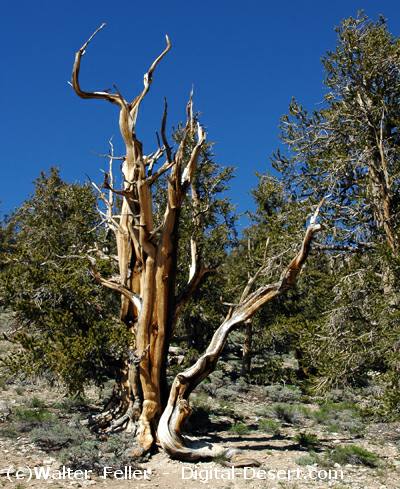Route 11
Ancient Bristlecone Byway
It's the very harshness of the ancient Bristlecone Forest on the crest of the White Mountains that enables the world's oldest known living trees to survive for thousands of years. At route's end in the windswept Patriarch Grove at 11,200 feet, violent storms alternate with stillness, silence and incredibly clear light.What to expect: The paved part of this route makes a steep, switchbacking climb. The last 13 miles are unpaved and mostly level but can be rough. All turns are well marked. The road is closed in winter; call the Inyo National Forest for information. There are toilets and picnic tables but no water at road’s end.
Length: 36 miles, one way.
Driving time: 1.5 to 2 hours one way.
Getting there: In Big Pine begin just north of town at the intersection of Highways 395 and 168.
Along the route: The tall tree at the intersection is a giant sequoia, planted in 1913 to commemorate the opening of Westgard Pass. No one would have realized they were planting the largest-growing tree species at the start of the route to the longest-living tree species— but this giant sequoia will never grow to giant size in a habitat so different from its home on the wet western side of the Sierra!
Head east, cross the Owens River and bear left to continue on Hwy. 168. At 3 miles you’ll reach a sign indicating 4,000’ elevation. Here are plants of the saltbush scrub community, well adapted to the low, dry valley where alkaline salts accumulate over the millennia: fourwing saltbush, named for the shape of its seeds; greasewood, bright lime-green; and Ephedra nevadensis, a grayish shrub that looks at first glance like nothing but twigs. It’s sometimes called Mormon tea or Indian tea, but local Paiutes say tea from this species makes you sick! They prefer the higher-elevation, dark green Ephedra viridis. Both are very mild relatives of the Chinese medicinal “ma huang,” source of the asthma medication ephedrine.
At 8 miles the desert vegetation is interrupted by shade trees around Toll House Spring. Scott Broder built the original toll road in 1853. The road crosses the mountain pass named by the Good Roads Club of Inyo County to honor A.L. Westgard of the American Automobile Association. Westgard Pass arbitrarily divides the White Mountains from the Inyo Mountains to the south.
At 9 miles you’re in the range of pinyon pines, surrounded by graygreen, fragrant sagebrush; bitterbrush, with tiny dark leaves; rabbitbrush, which blooms bright yellow in early autumn; and the real Indian tea, Ephedra viridis. At 10 miles you’ll go through the first of three rocky narrows. The dark brown rocks in the first are siltstones and sandstones; in the second and third, blue limestones prevail.
After 12 miles the road levels out at Cedar Flat. The pinyons have been joined by junipers, sometimes miscalled cedars.
At 13 miles turn left onto road 01, paved and marked as the road to the Bristlecones. Here’s a nice patch of an interesting native grass. The western deserts have several varieties of needlegrass, named for their long needle-like bristles, called awns; this species has awns so long and thin that it’s called “needle-and-thread grass.” A mile farther the road passes through stands of a tall native grass, Great Basin wild rye.
At 16 miles is a picnic area; at 17 miles, the 8,000’ level; at 20 miles, 9,000’. Beyond this the pinyons end and the high-elevation pines, limber and bristlecone, begin. Both have needles in bundles of five but bristlecone needles grow on long, narrow, sometimes twisty, bottlebrush-like branchlets. Limber pine, along with sagebrush, grows on predominantly quartzite and shale soils but bristlecones occupy lowernutrient, higher-moisture dolomite soil. Here they have little competition and, with so few plants, fires don’t spread far. Slow growth makes for extra-dense wood that resists insects, disease and rot; the oldest bristlecones survive on the most barren, coldest, windswept sites, sometimes by virtue of a single narrow strip of bark.
Beyond the 10,000’ mark is the turnoff to Schulman Grove—named for Dr. Edmund Schulman who discovered in the 1950s just how old these trees are—stop by the visitor center and interpretive trails, then continue on the dirt road to Patriarch Grove (4S01). Wild currant bushes flank the road here. Leave the berries for the birds and bears: all natural features, including plant materials dead or alive, are protected throughout the Ancient Bristlecone Forest. “Patriarch” is the largest bristlecone in the world but a mere 1,500 years old. “Methuselah,” 4,723 years old when discovered in 1957, remains the oldest known living tree.
.. Source - BLM

